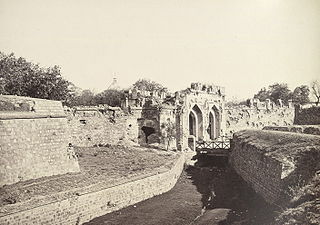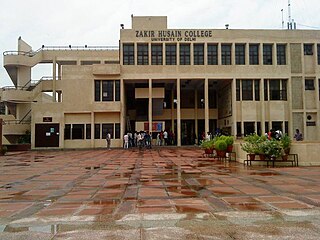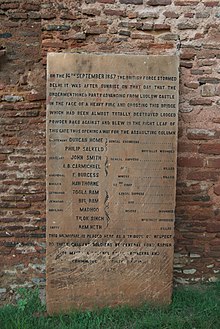The Mudrika Seva is one of the most popular bus routes in Delhi, India. It was started by the Delhi Transport Corporation (DTC) in May 1974, and is now operated by both the Corporation and DIMTS' cluster buses. The service runs on Delhi's inner ring road, with major stops at AIIMS, Lajpat Nagar, Sarai Kale Khan, ITO, Delhi Gate, Kashmere Gate, DU North Campus, Model Town, Azadpur market, Shalimar Bagh, Punjabi Bagh, Britannia Factory, Rajouri Garden, Naraina, and DU South Campus.

Sadar Bazaar is the largest wholesale cosmetics jewellery market of household items in Old Delhi, Delhi, India.

Old Delhi is an area in the Central Delhi district of Delhi, India. It was founded as a walled city named Shahjahanabad in 1648, when Shah Jahan decided to shift the Mughal capital from Agra. The construction of the city was completed in 1648, and it remained the capital of Mughal India until its fall in 1857, when the British Empire took over as paramount power in the Indian subcontinent.

Purana Qila is one of the oldest forts in Delhi, India. It was built by the second Mughal Emperor Humayun and Surid Sultan Sher Shah Suri. The fort forms the inner citadel of the city of Dinpanah. It is located near the expansive Pragati Maidan exhibition ground and is separated from the Dhyanchand Stadium by the Mathura Road, Delhi.

General Bakht Khan (1797–1859) was the commander-in-chief of the Indian rebel forces in the city of Delhi during the Indian Rebellion of 1857 against the East India Company.

The Inner Ring Road refers to one of the two main ring roads, the main inner one and an outer one in Delhi, India. The two ring roads have a combined length of 87 km (54 mi). There are two less significant Ring Roads in Delhi apart from the above two, namely the Rural Ring Road, that runs across the rural areas on the fringe of North West Delhi and West Delhi Ring Road, limited only to the West Delhi region.

The Siege of Delhi was one of the decisive conflicts of the Indian Rebellion of 1857. The rebellion against the authority of the East India Company was widespread through much of Northern India, but essentially it was sparked by the mass uprising by the sepoys of the Bengal Army, which the company had itself raised in its Bengal Presidency. Seeking a symbol around which to rally, the first sepoys to rebel sought to reinstate the power of the Mughal Empire, which had ruled much of the Indian subcontinent in the previous centuries. Lacking overall direction, many who subsequently rebelled also flocked to Delhi.
In India, an Inter State Bus Terminal or Inter-State Bus Terminus (ISBT) is a bus terminus that provides bus service to destinations located in other states. An ISBT may also provide bus services to destinations in the same state. Mostly ISBT Term is used in the Northern Part of India, In the western part of India, ST Stand or State Transport Term is used.
The Civil Lines is a residential area and one of the 3 subdivisions of the Central Delhi district of Delhi in India. It is one of the 12 zones under the Municipal Corporation of Delhi. It was the hub of European-style hotels in the city until New Delhi came into being in 1911. The official residence of the Lieutenant Governor of Delhi is also located at Raj Niwas Marg, Civil Lines.
Dashrath Puri is a small colony consisting of around 1000 houses situated on Dabri-Palam road in South West Delhi, India. Currently this colony comes under Dwarka and West Delhi . Schools : Jindal Public School Coaching Centre : A.K Institute of Studies, Street no 4 Dabri Village Pitajis Bridhashram at B-1/1 near Shani mandir houses old and destitute patients. Bridhashram also runs free allopathic, homeopathic and dentist OPDs in dispensary.

Zakir Husain Delhi College, founded in 1696, is the oldest existing educational institution in India, and is a constituent college of the University of Delhi, accredited with NAAC 'A++' grade. The college comprises an area of 150 acres. The college is situated in south campus of University of Delhi It has had a considerable influence on modern education as well as Urdu and Islamic learning in India, and today remains the only Delhi University college offering BA (Hons) courses in Arabic and Persian.

St. James' Church was once the official church of the British Viceroy of India in Delhi, India. The building, which was built in 1836 for Colonel James Skinner, is one of the oldest churches in the city. It remains part of the Church of North India Diocese of Delhi.

The Gates of Delhi were city gates at various medieval townships around Delhi, built under dynastic rulers in the period that could be dated from the 8th century to the 20th century. They are the gates in:

Kashmere Gate, also known as Kashmiri Gate, is an important metro station on Delhi Metro in Delhi, which is elevated for the Red Line and underground for both the Yellow Line and Violet Line. It is a transfer station between the Red Line on the highest upper level, the Yellow Line on the lowest underground level and Violet Line on the parallel underground level. It is the busiest metro station in India. It was named on 25 December 2002. During peak hours, it serves as an alternate Northern Terminus for the yellow line along with Vishwa Vidyalaya.

Dr. B. R. Ambedkar University Delhi, formerly Bharat Ratna Dr. B. R. Ambedkar University Delhi and Ambedkar University Delhi, and simply AUD, is a state university established by the Government of the NCT of Delhi through an Act of the Delhi Legislature. The university began functioning in August 2008. It is a Unitary non-affiliating University whose main focus is on undergraduate and postgraduate studies and on research in the Humanities and the Social Sciences. It is completely funded by the State Government of the NCT of Delhi. The university is now declared eligible to receive Central Government Assistance. The university has been graded 'A' by National Assessment and Accreditation Council. It is named after the polymath B. R. Ambedkar, the architect of the Indian Constitution and one of the founding fathers of India.
University School of Chemical Technology (USCT) is one of the constituent school of Guru Gobind Singh Indraprastha University.

Nicholson Cemetery, formerly known as the Old Delhi Military Cemetery and the Kashmere Gate Cemetery, is a Christian cemetery located in Kashmere Gate, Delhi, India. It is located near the Kashmere Gate Metro Station and west of the Inter State Bus Terminal. It is the site of the earliest known Christian burials in Delhi NCR. The cemetery was established in 1857 and is named after Brigadier-General John Nicholson, a Victorian era military officer who played a pivotal role during the Indian Rebellion of 1857. The St. James' Church, who owns the cemetery, is the oldest place of worship for the Christian community of Delhi. The church along with cemetery, St. Stephen's hostel, and the Victorian era houses of Kashmere Gate neighbourhood were once considered to be a "centripetal" part of Christians in Delhi.

Majnu-ka-tilla (MT) is a colony in Delhi, India that was established around 1950. Majnu-ka-tilla is officially called New Aruna Nagar Colony, Chungtown, and Samyeling. It is part of North Delhi district and is located at the bank of the Yamuna River (NH-1) near ISBT Kashmiri Gate.

The Maharana Pratap Interstate Bus Terminus (Maharana Pratap ISBT), popularly known as Kashmere Gate Interstate Bus Terminus (Kashmere Gate ISBT), located in Delhi, is the oldest and one of the biggest Inter-State Bus Terminals in India. It operates bus services between Delhi and the neighbouring states and union territories of Haryana, Jammu and Kashmir, Ladakh, Punjab, Himachal Pradesh, Uttar Pradesh, Rajasthan and Uttarakhand. Spanning about 5.3 acres, it handles over 1,800 buses a day.
Dabri is a residential colony in South West Delhi. It comes under Dwarka Assembly constituency.

























